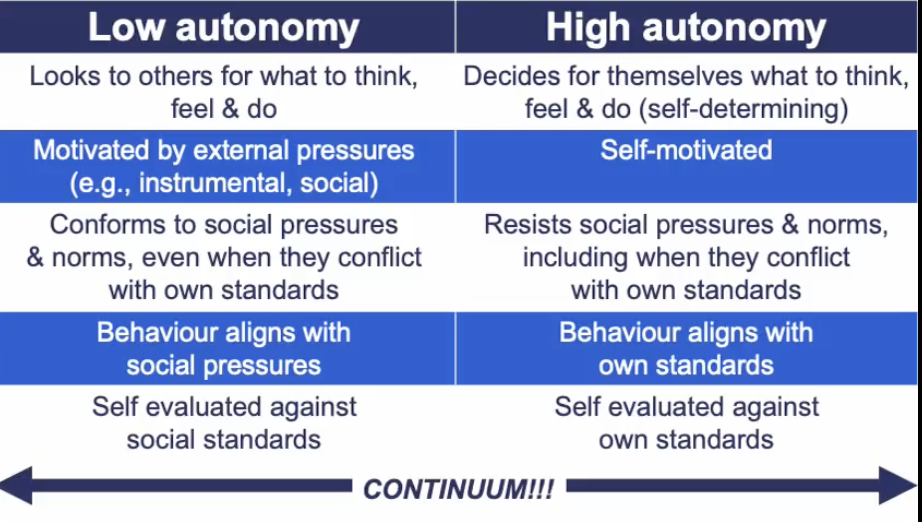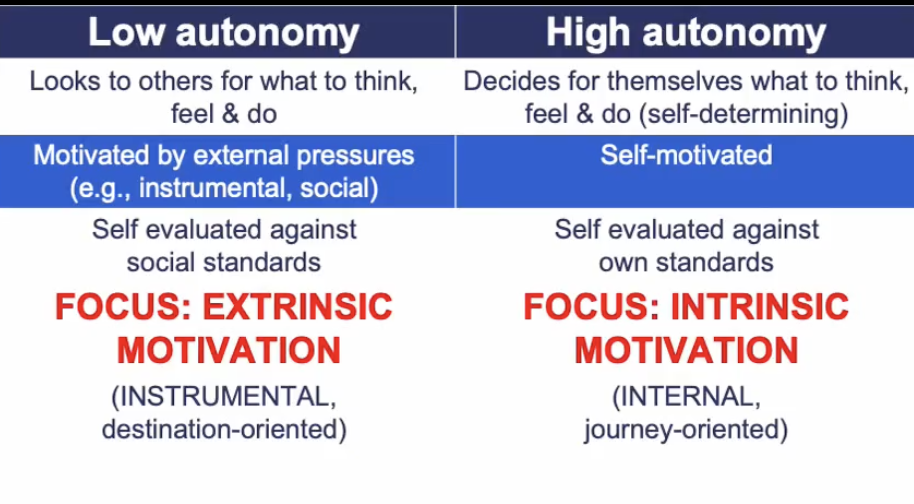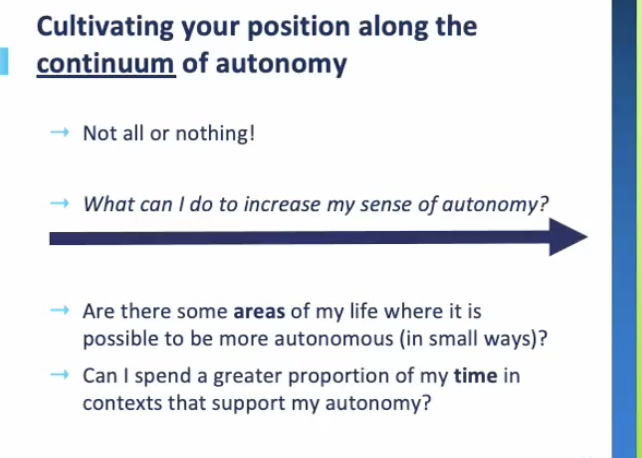Autonomy and Well-being Lecture Notes
What is Autonomy?
Definition: Autonomy is the degree to which we are free to self-determine our thoughts, feelings, and actions in accordance with our own values and standards.
Ryff's Psychological Well-being Model: Identifies autonomy (green) and positive relationships (orange) as key components. This can seem paradoxical, but they are not in conflict.
Autonomy is NOT Independence:
A common misconception is that autonomy means independence (non-reliance on others).
Autonomy is about self-determination (picking our direction, making choices right for us, following through).
Science indicates connectedness to others is vital for well-being; we can willingly depend on others to achieve self-determination.
It is not about stepping away from others to be different or necessarily having different values.
It is not linked to individualism or only beneficial in individualistic cultures; it has an important role in collectivist societies too.
It's not about ignoring societal rules or norms.
High Autonomy vs. Low Autonomy (Continuum):
Self-determination:
High Autonomy: Decides for self what to think, feel, do.
Low Autonomy: Looks to others for what to think, feel, do.
Motivation:
High Autonomy: High self-motivation (intrinsic).
Low Autonomy: Motivated by external pressures (instrumental rewards, social media).
Social Pressures:
High Autonomy: Able to resist social pressures and norms, especially when they conflict with own standards.
Low Autonomy: Conforms to social pressures and norms, even when they conflict with own standards (e.g., peer pressure).
Behavior Alignment:
High Autonomy: Behaves in ways that align with own standards.
Low Autonomy: Behavior aligns with social pressures, may not feel right for the individual.
Self-evaluation:
High Autonomy: Self-evaluates against own standards, prioritizes what's important for oneself, feels proud of consistent values.
Low Autonomy: Evaluates self against social standards, cares more about what others thin

.
Autonomy as a Continuum: Like many psychological constructs, autonomy varies day-to-day and context-to-context.
Quiz: Ranking Autonomy (Kim's Assignment Scenario):
Scenario: Kim values learning. Housemates tease her to go out instead of studying for an assignment due tomorrow.
Option 3 (Highest Autonomy): Kim stands her ground, explains assignment importance, stays home, consistent with her value of learning.
Option 2 (Second Highest Autonomy): Kim goes out, giving up study time, but values and enjoys her friendships (acting consistent with a different, but still personal, value).
Option 1 (Lowest Autonomy): Kim goes out, giving up study time, even though she values and enjoys learning (conforming to social pressure despite conflicting values).
Personal Autonomy Check-up (Ryff and Keyes' Autonomy Scale):
Instructions: Rate 7 items from 1 (strongly disagree) to 6 (strongly agree).
High Autonomy Items (1, 2, 5, 7): High scores (e.g., 5, 6) indicate high autonomy, reflecting a strong sense of self-direction and independence in decision-making.
Low Autonomy Items (3, 4, 6): For these items, which are typically inversely worded, high scores (e.g., 5, 6) would indicate lower autonomy, and are often reverse-scored for total scale calculation.
Interpretation: A higher overall total score across all 7 items (after any necessary reverse-scoring) suggests a greater level of personal autonomy.
why is autonomy important
Fosters Intrinsic Motivation: When individuals feel autonomous, they are more likely to be driven by internal desires and interests rather than external rewards or pressures, leading to greater engagement and persistence.
Promotes Self-Congruence: Acting in alignment with one's own values and standards, a hallmark of high autonomy, leads to a stronger sense of self and authenticity.
Supports Personal Growth and Learning: The freedom to self-determine allows individuals to explore, make choices, learn from experiences, and develop a unique personal identity.
Builds Resilience: The ability to resist social pressures and adhere to personal standards, even when challenging, strengthens one's resolve and capacity to cope with adversity.
Self determination theory:
self governing
autonomy is a basic psychological need
associated with intrinsic motivation
associated with pursuing intrinsic goals

skinner (1953) - operant conditioning
Deci: cognitive evaluation theory (CET)
Emphasises role of psychological needs in human motivation
“effects of an event such as reqard depend on how it affects perveived self-determination”
rewards can be interpreted as controlling
if higher on extrinsic motivation, promotion tends to go down
intrinsic motivation - better
higher autonomy associated with
better adjustment to relocation in older adults
lower levels of depression symptoms in older adults in aged care
how do we develop autonomy
Self-reflection: Regularly considering one's own values, beliefs, and aspirations helps clarify what truly matters.
Conscious Decision-Making: Practicing making choices that align with personal values and goals, rather than defaulting to external pressures.
Setting Boundaries: Learning to identify and communicate limits when social demands conflict with personal standards or needs.
Taking Responsibility: Owning decisions and their consequences, fostering a sense of control and self-efficacy.
Seeking Internal Motivation: Identifying and pursuing activities that are inherently enjoyable or meaningful, rather than relying on external rewards or validation.
major developmental tasks
understand “self” as separate, with own unique perspective
clear sense of “who i am” (e.g. values, purpose)
competencies, mastery (e.g. assertiveness)
context = how well does “who i am” align with societal pressures?
Adolescence: ‘who i am’ formation
increase in “exploratory behaviours’
individuating from parents (psychologically, as well as physically)
parents de-idealised —> imperfect (Beyers & goossens, 1999)
formation of own belief system, values
positive parent-child relationship supports process —> optimal outcomes
context matters:
what do autonomy supportive environments look like?
choice
freedom to try, solve
freedom to initiate
meaningful rationale if direction is given
positive outcomes in various outcomes
but context is not determinative
cultivating autonomy
Nurturing Choice: Providing opportunities for individuals to make meaningful choices, even in small ways, to develop their sense of agency.
Creating Supportive Environments: Fostering contexts where individuals feel safe to express their thoughts, feelings, and make independent choices without fear of reprisal.
Minimizing Controlling Language and External Pressures: Reducing the use of demands, threats, or excessive rewards that can undermine internal motivation and self-determination.
Promoting Intrinsic Goal Setting: Encouraging individuals to set and pursue goals that are personally valuable and interesting to them.
Developing Self-Compassion: Recognizing that mistakes and setbacks are part of the learning process and allowing for self-forgiveness facilitates continued growth in autonomy.
choose contexts that align with our values and purpose

Cognitive reapprasal:
involved changing the way individual thinks about a potentially emotion-eliciting situation in order to modify its emotional impact
how we interpret situations can influence our wellbeing: threat or challenge?
mental arithmetic task, under surveillance
threat instructions: “emhasised the importance of completing the task as quickly and accurately as possible and that reponses would be scored for speed and accuracy”
challenge instructions: “think of the task as a challenge and… youself as someone capable of meeting that challenge
challenge intructions —> more adaptive physiological responding during task
extensive body of research
key role in current psychological interventions
brief cognitive reappraisal intervention = 1 of 3 studies in the psychologocal science accelerator covid-19 rapid project, spanning 55 countries (wang et al, 2020)
a good strategy
seminal study by gross and john 2003 found CR was associated with:
reduced negative emotion
increased positive emotion
better social functioning
increased psychological wellbeing
large meta analysis aldao et al 2010 found CR was associated with reduced psychopathology
situation-strategy fit
whether or not a strategy is adaptive depends on the situation
theoretical argument: CR most important (for psychological wellbeing) when situational control is low
emerging evidence:
troy et al (2016) found CR was associated with
lower levels of depression for people experiencing uncontrollable stress
but higher levels of depression for people experiencing controllable stress
2017 troy et al found CR.was associated with lower levels of depression for people with low SES but not high SES
bulls eye task - a method used to assess an individual's ability to set and achieve personal goals, highlighting the importance of autonomy in managing stress and enhancing well-being. This underscores the idea that fostering personal autonomy can be a powerful tool in reducing depressive symptoms and improving overall mental health, particularly for those in challenging socioeconomic circumstances.